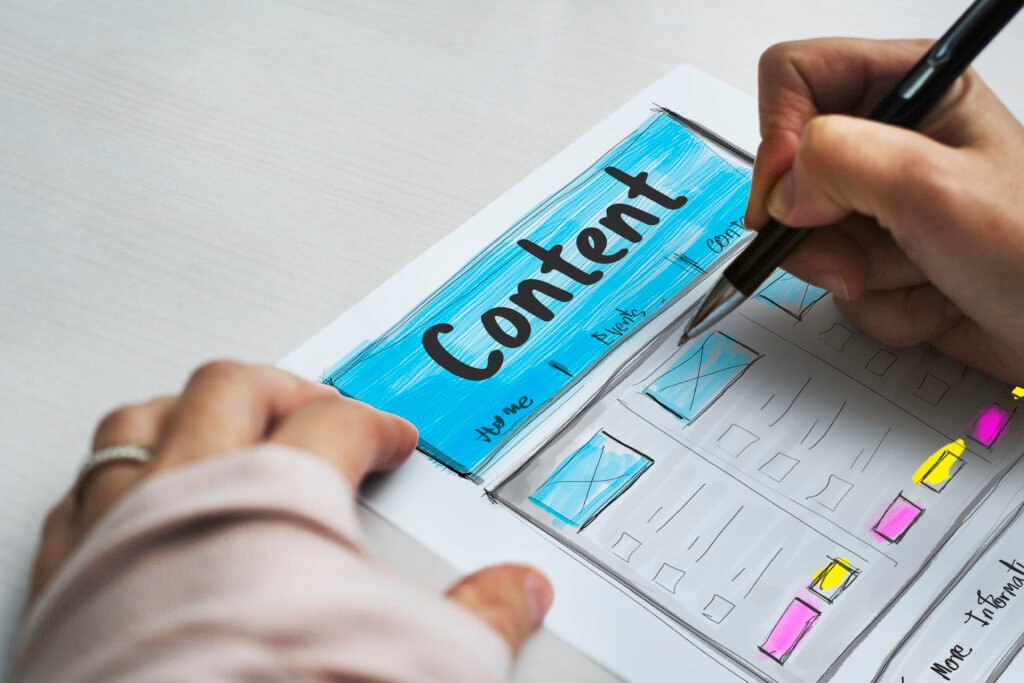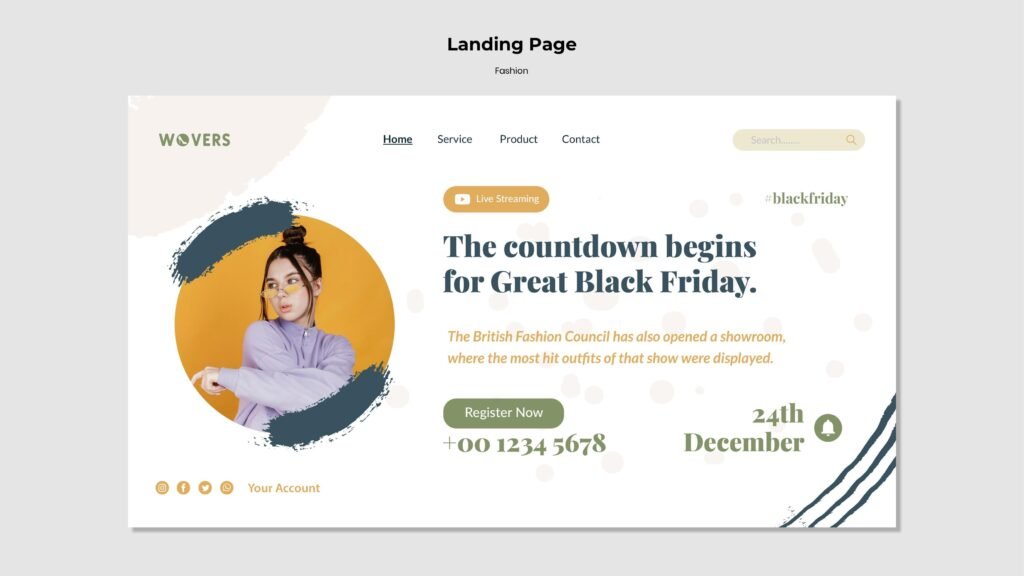Landing page, this is one of the best tools every brand must have in its digital marketing arsenal. They are the ultimate conversion machines as they act as the dedicated pitstops for your targeted audience, meticulously designed to nudge them towards a desired action. But what exactly are landing pages, and why are they so crucial for your marketing success?
To give an overview, landing pages are standalone web pages created specifically for marketing or advertising campaigns. They’re where a visitor “lands” after clicking on a link in an email, or ads from Google, Bing, YouTube, Facebook, Instagram, X, or similar places on the web. Unlike web pages, which typically have many goals and encourage exploration, landing pages are designed with a single focus or goal, known as a call to action (or CTA, for short).
Imagine a visitor clicks on your enticing social media ad about a new fitness program. Instead of landing on your website’s homepage filled with various navigation options, they arrive at a focused page brimming with information about the program, its benefits, and a clear call to action (CTA) to sign up for a free trial. That’s the magic of a landing page – a standalone web page designed with a singular goal: to convert visitors into leads or paying customers.
It’s this focus that makes landing pages the best option for increasing the conversion rates of your marketing campaigns and lowering your cost of acquiring a lead or sale.
This article will delve into the intricacies of landing pages, from their structure and design to content creation and optimization strategies, providing you with a thorough understanding of this essential marketing tool.
Exploring the Different Types of Landing Pages
Understanding the various types of landing pages empowers you to craft campaigns and tailored content that meet your objectives and that of your target audience. Let’s delve into some common types of landing pages:
1. Lead Generation Landing Pages
Lead generation pages focus on collecting contact information from visitors. These pages typically feature a lead capture form where users can input details such as name, email address, and sometimes additional information relevant to the business. Marketers often offer incentives like free e-books, webinars, or discounts to entice visitors to provide their information.
2. Click-Through Landing Pages
Click-through landing pages act as a bridge between an advertisement and the final destination, usually an e-commerce product page or a signup form. These pages provide concise information about the product or service and encourage visitors to click through to the next stage of the sales funnel. They are effective in pre-qualifying visitors and improving conversion rates by ensuring that users are genuinely interested before proceeding further.
3. Product Detail Landing Pages
Product detail pages are dedicated to showcasing a specific product or service in detail. They provide comprehensive information, including features, benefits, and specifications, and often include images or videos to enhance the user experience. These pages aim to persuade visitors to purchase by addressing their pain points and demonstrating the value proposition of the offering.
4. Splash or Welcome Pages
Splash or welcome pages serve as an introduction to a website or a campaign. They are visually striking and typically feature minimal content with a strong call-to-action directing users to proceed further into the website or take a specific action. While splash pages can effectively capture attention, they should be used sparingly to avoid frustrating users who are seeking immediate information.
5. Thank You Pages
Thank you pages are displayed after a visitor has completed a desired action, such as submitting a form or making a purchase. These pages acknowledge the user’s action, express gratitude, and often provide further instructions or resources. Thank you pages offer an opportunity to reinforce brand messaging, encourage social sharing, or suggest additional products or services.
6. 404 Error Pages (Customized Landing Pages)
Customized 404 error pages are designed to engage and redirect visitors who encounter a broken link or reach a non-existent page on a website. Instead of a generic error message, these landing pages can be creatively crafted to guide users back to relevant content, encourage exploration, or offer assistance.
The Anatomy of a Landing Page

The effectiveness of a landing page is largely determined by its components. Each element plays a crucial role in engaging visitors and encouraging them to take action. Here are the key elements:
- Headline and Subheadline: The headline is the first thing visitors see. It must be compelling and clear about the offer. A subheadline supports the headline, offering a secondary message of value.
- Unique Selling Proposition (USP): The USP is what distinguishes your offer from competitors, highlighting the benefits that make your product or service special.
- Images and Videos: Visuals can communicate more about your offer than words alone. They can also help visitors understand how your product or service works. They should be high quality and relevant to your product or service.
- Features and Benefits: List the features of your product or service and explain how they benefit the user.
- Social Proof and Testimonials: These build trust by showing that others have had a positive experience with your product or service.
- Call-to-Action (CTA): The CTA is perhaps the most critical element of a landing page. It’s what converts a visitor into a lead or customer.
Designing Landing Pages That Convert
Design plays a pivotal role in the success of a landing page. It’s what helps visitors understand what they’re getting and why it’s valuable. A well-designed landing page can also help build trust with your audience, which is crucial for converting them into leads or customers. Here are some design principles to follow:
- Principles of Landing Page Design: Keep it simple, use contrasting colors for the CTA, and ensure the most important information is above the fold.
- Colour Scheme: Colors can evoke emotions and actions. Choose a color scheme that aligns with your brand and the emotions you want to evoke.
- Layout and White Space: A clean layout with ample white space can help focus attention on the most important elements.
- Compelling CTAs: Your CTA should stand out and make it clear what the visitor will get by clicking.
- Mobile Optimization: With the increasing use of mobile devices, your landing page must be responsive and look great on any device.
Designing highly-converting landing pages is one topic we have written extensively on, click here for more details.
Writing Content for Landing Pages
Content is king, and this is especially true for landing pages. Here’s how to write content that converts:
- Crafting a Headline: Your headline should be clear, concise, and compelling. It should offer value and make the visitor want to read on.
- Writing Persuasive Copy: Use persuasive writing techniques such as addressing the reader’s pain points, using powerful words, and showcasing benefits.
- Storytelling: A good story can captivate an audience. Use storytelling to relate to your audience and show them the human side of your brand.
- Creating Urgency: Limited-time offers and exclusive deals can create a sense of urgency that encourages visitors to act now.
- SEO Considerations: Optimize your landing page for search engines to increase visibility and drive more traffic.
Landing Page Optimization
Merely having a landing page is not enough to guarantee conversions. To ensure your landing page converts, the true magic lies in optimization – the process of refining and enhancing your landing pages to maximize their effectiveness in converting visitors into leads or customers. This is a key aspect of building a landing page.
Let’s explore the fundamental principles of landing page optimization and how you can leverage them to unlock the full potential of your campaigns.
- Clear and Compelling Value Proposition: A strong value proposition is the cornerstone of any successful landing page. Visitors should immediately understand what the page offers and why it’s valuable to them. Whether it’s a product, service, or resource, clarity is key. Use concise and persuasive language to communicate the benefits and unique selling points upfront.
- Streamlined Design and User Experience: A cluttered or confusing layout can deter visitors and hinder conversions. Opt for a clean and intuitive design that guides users seamlessly toward the desired action. Minimize distractions, prioritize important elements such as headlines and call-to-action buttons, and ensure that the page is optimized for mobile devices for a consistent experience across all devices.
- Compelling Call-to-Action (CTA): The call-to-action is the catalyst for conversion. Make it prominent, compelling, and action-oriented. Use persuasive language that encourages visitors to take the next step, whether it’s making a purchase, signing up for a newsletter, or downloading a resource. Experiment with different colors, placement, and wording to optimize CTA effectiveness.
- A/B Testing and Iterative Improvement: A/B testing is a powerful technique for refining landing pages and uncovering what resonates most with your audience. Test different elements such as headlines, imagery, CTA buttons, and form fields to identify the most effective combinations. Continuously monitor performance metrics such as conversion rate, bounce rate, and time on page, and iterate based on insights gleaned from testing.
- Personalization and Targeting: Personalization can significantly enhance the relevance and effectiveness of landing pages. Tailor content, messaging, and offers based on user demographics, behavior, or past interactions to create a more personalized experience. Dynamic content and smart segmentation strategies can help deliver the right message to the right audience at the right time, increasing engagement and conversions.
- Optimized Loading Speed: In today’s fast-paced digital landscape, speed matters. Slow-loading pages can frustrate visitors and lead to high bounce rates. Optimize landing page loading speed by minimizing image sizes, leveraging browser caching, and optimizing code. Tools like Google’s PageSpeed Insights can help identify areas for improvement and enhance overall performance.
- Comprehensive Analytics and Data Analysis: Data-driven decision-making is essential for effective optimization. Implement robust analytics tools such as Google Analytics to track and analyze visitor behavior, traffic sources, and conversion metrics. Gain insights into what’s working well and where improvements are needed, and use data to inform optimization strategies moving forward.
RELATED TOPIC: Best Practices for Website Landing Page Design and Optimization
Beyond the Basics: Advanced Landing Page Strategies
As you gain experience, consider these additional tactics to elevate your landing page game:
- Social Proof: Showcase testimonials, logos, or trust badges to build credibility and encourage conversions.
- Scarcity and Urgency: Create a sense of urgency with limited-time offers or limited quantities to drive immediate action.
- Video Integration: Explainer videos or product demos can effectively capture attention and communicate value propositions.
- Retargeting Ads: Re-engage visitors who didn’t convert initially with targeted ads reminding them about your offer.
- Dynamic Content: Change content based on user behavior or demographics.
- Progressive Profiling: Gradually collect more information about your leads through form fields.
- Multi-Step Landing Pages: Break up the conversion process into multiple steps to avoid overwhelming visitors.
Case Study: Effe Towers’ Landing Page Optimization for HealthiFit
Client Background
Qilo a burgeoning fitness and lifestyle solution, sought to increase its user base through targeted campaigns. They approached Effe Towers to create a landing page that would not only attract potential users but also convert them at a high rate.
Objectives
The primary goal was to design a landing page that would:
- Communicate the benefits of Qilo.
- Encourage sign-ups for the solution.
- Establish a strong brand presence.
Strategy
Effe Towers employed a data-driven approach, focusing on user experience (UX) and conversion rate optimization (CRO) principles. The strategy included:
- Market research to understand the target audience.
- A/B testing to refine messaging and design elements.
- SEO optimization to improve organic reach.
Execution: Design and Content
- Headline: Crafted a compelling headline that resonated with the target demographic, emphasizing the transformative journey Qilo offers.
- Visuals: Integrated high-quality images and videos showcasing real user transformations.
- Copy: Developed persuasive and concise copy that highlighted the solution’s unique selling points and user testimonials.
- Lead Capture: Implemented a simple form to sign up for a free trial, incentivized with a discount on future subscription plans.
- CTA: Designed a prominent ‘Start Your Journey’ button, contrasting with the page’s color scheme to stand out.
Technical Aspects
- Responsive Design: Ensured the landing page was fully responsive across all devices.
- Page Speed: Optimized for fast loading times to reduce bounce rates.
- Analytics: Integrated tracking tools to monitor user behavior and conversion metrics.
Results
After a month of going live, the landing page achieved:
- A conversion rate increase of 45%.
- A bounce rate reduction to 25%.
- The average time on the page increases by 30 seconds.
- A traffic source diversification, with 60% coming from organic search.
Conclusion
Landing pages are a powerful tool in the entrepreneur and the digital marketer’s arsenal. They can significantly increase conversions and contribute to the success of any campaign. As we look to the future, landing pages will continue to evolve, incorporating new technologies and strategies to remain effective.
By mastering the art of landing pages, you can transform your marketing efforts from awareness generation to action-driven success. Remember, an exceptional landing page acts as a persuasive guide, nudging visitors along the path to conversion and ultimately, building a loyal customer base for your business.
Do not hesitate to contact Effe Towers. Our team of experts specializes in creating professionally designed, search-engine-optimized landing pages that convert. Get in touch today and watch your conversions soar!



